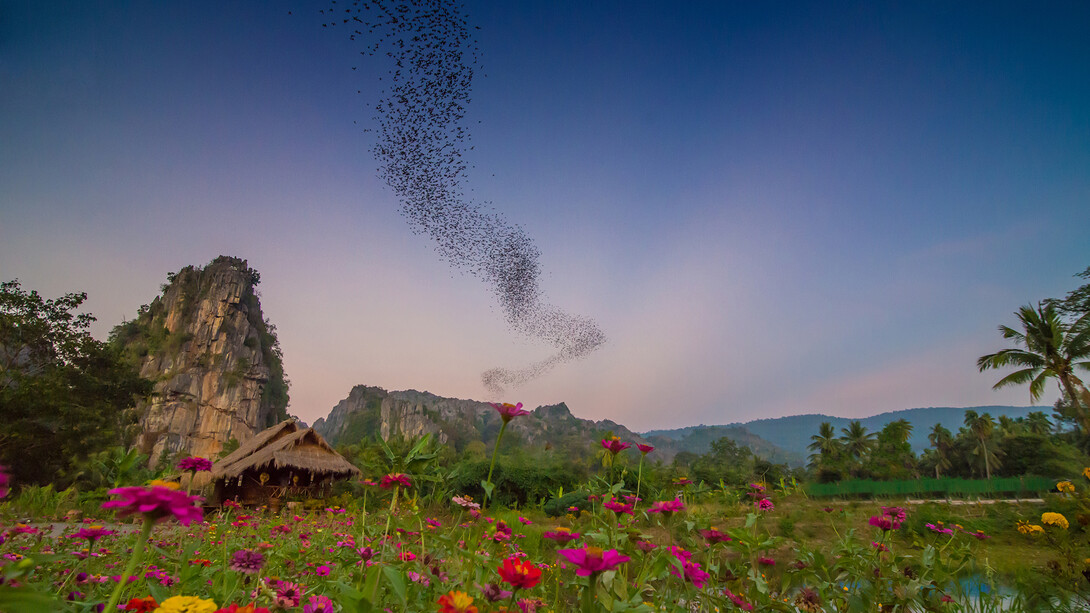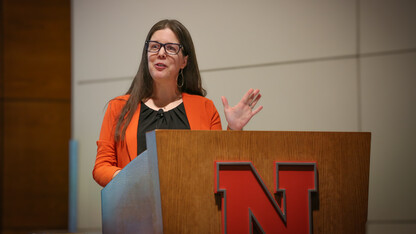
A strikingly literal case of perception shaping reality could explain a paradox involving nectar-producing flowers and the bats that pollinate them, says new research from the University of Nebraska-Lincoln and several European institutions.
Published in the journal Science, the study addresses a decades-old riddle of evolutionary biology: How did flowers that rely on pollination by sweet-toothed bats evolve nectar containing only moderate concentrations of sugar? Though bats have shown a preference for nectar consisting of up to 60 percent sugar, flowers that manage to attract the winged mammals generally offer doses of 18 to 23 percent.
“If a flower is trying to attract animals to visit it and drink its nectar, then one would think it would give the animals what they most like,” said co-author Alan Kamil, professor emeritus of biological sciences. “But if you put out different concentrations of nectar to nectar-feeding bats, you find out that they like (those) that are much sweeter and more concentrated than what the flowers are offering. That’s weird.
“Solving these kinds of riddles is central to advancing our understanding of how traits evolve.”
After conducting field experiments in Costa Rican rainforests, lab experiments in Germany and simulations of genetic evolution via computer, the researchers concluded that nectar-feeding bats struggle to make fine distinctions between sweetness as sugar concentrations reach a certain threshold. If true, flowers producing nectar at that threshold would have received more visits from bats and other nectar-feeding animals, ultimately winning the race to spread their pollen and their nectar-coding genes.
The study’s explanation stems from the Weber-Fechner law, which describes how an organism’s ability to perceive differences in a stimulus – here, both the sweetness and volume of nectar – depends on the initial value and relative changes of that stimulus. If a bat slurps nectar containing 15 percent sugar before sampling some with 20 percent – an absolute increase of just five percent, but a proportional leap of 33 percent – the bat will likely notice the difference. Yet if the bat drinks a 45-percent variety and then tries a 50-percent brew, the Weber-Fechner law says that the difference may well go undetected.
The researchers demonstrated that the law is especially relevant when bats face intense competition for nectar, forcing them to also consider the volume of nectar in one flower versus another. Surrounded by a rainforest of thirsty neighbors, a bat will encounter more flowers with only a small amount of nectar – making it easier to perceive differences in volume. Though increasing the number of bats in a lab experiment did lower sugar concentrations from 30 to 24 percent, the competition had a much more dramatic effect on volume, dropping the average amount from 60 to six milliliters.
When nectar volume is that low and sugar concentration is at least moderate, a flower that can offer even a few extra milliliters of precious nectar seems to catch a bat’s attention more than one presenting a bit of extra sugar, the authors said. And by prioritizing quantity over quality, bats likely began favoring and pollinating flowers that produce only moderately sweet nectar – allowing the responsible genes to win the evolutionary battle against their sweeter rivals.
Artificial flowers, virtual genes
The team reached its conclusions by employing techniques that Kamil and co-author Alan Bond, a fellow professor emeritus of biological sciences at Nebraska, helped refine over several decades. One of those techniques came from the realm of virtual ecology, which uses algorithm-based simulations to determine how the naturalistic behaviors of one organism can shape the evolution of another.
Back in the 1970s, Kamil figured out that he could train blue jays to “hunt” for images of camouflaged moths akin to those they encountered in the wild. Later, Kamil and Bond developed a technique that combined this behavioral testing with computer simulations to predict how aspects of the moth’s camouflage affected the ability to avoid detection by predatory blue jays, leading moth populations to flourish or decline over the course of generations.
Throughout that span, Kamil was also studying the spatial memory of birds, including nectar-feeding species that could remember the locations of flowers. Those studies later drew the attention of Germany-based researcher York Winter, who invited Kamil to visit several times in the mid-2000s. During a series of free-ranging discussions, Kamil and Winter began chewing on the bat-nectar paradox.
“The normal laboratory circumstances under which you observe what nectar the bats prefer is a very artificial one,” Kamil said. “There’s an unlimited amount of nectar; they can have as much as they want and get to choose freely from among several different sources. That’s fine, as far as it goes, but it’s not really the way it is when a lot of bats are feeding on flowers. The bats are competing with each other for the nectar, and the flowers are competing with each other for the bats.
“We felt … it was quite possible that something about the way the nectar is actually competed for is what’s producing this apparently surprising result. But we needed a way to study it.”
Then, in what Kamil called a “sudden flash,” they devised the framework of a virtual ecology experiment that would finally solve the riddle.
Winter and colleague Vladislav Nachev had designed artificial flowers with sensors that could detect the presence of bats and radiofrequency receivers that could differentiate the bats based on the unique frequencies of their radio tags. The researchers placed 23 of the flowers in a Costa Rican rainforest known to house the nectar-feeding Glossophaga commissarisi bat, connecting the flower array to a pump system that allowed them to remotely control nectar volume and sugar concentration.
Much like their biological counterparts, the artificial flowers contained virtual sets of genes that determined the sugar concentration of their nectar. By tracking which bats visited which flowers, then crossing the genes of the parent flowers that were “pollinated” by visiting bats, the team could simulate the next generation of offspring on a daily basis. Each night for several weeks, the team altered the flowers’ nectar according to the genetic profile yielded by the previous day’s pollination. The team did this twice – once with a lineage that boasted 42 percent sugar, the second time with a line that offered just 18 percent. In both cases, sugar concentration evolved to an equilibrium of about 36 percent within just 10 to 12 generations.
To verify these findings, Bond helped develop evolutionary modeling simulations that included two factors: the extent to which sugar concentration influenced a bat’s likelihood of visiting a flower, and the amount of nectar available in an average flower. The first factor attempted to quantify any existing effects of the Weber-Fechner law, with the latter accounting for the effects of competition on nectar quantity. Only the simulations that incorporated a sweetness threshold and low quantities of nectar matched up with the results of the team’s field experiment, supporting the hypothesis that both quality and quantity contributed to the evolution of milder nectar.
Though conceiving and implementing the study’s multidimensional methodology demanded significant time and effort – spanning three continents and several years – Kamil said it allowed the team to address a question that probably could not have been answered otherwise.
“I hope that having set an example … will encourage more work of this type,” Kamil said. “It’s hard, but it’s needed. While ‘survival of the fittest’ sounds simple, studies that examine how this principle actually works in nature reveal a complexity and beauty that’s delightful to behold.”








